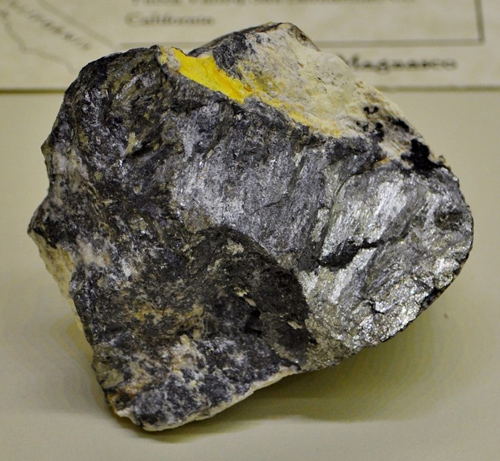The Mineral antimony

Antimony is a native element that can occur in a natural state, but it is rarely pure. It almost always contains some arsenic, and may also contain traces of silver, iron, and sulfur. On a fresh or preserved surface, Antimony has a tin-white color with a slight blue tinge. Otherwise, it is dark gray due to tarnish. Specimens of native Antimony are usually rather dull and ugly, as they usually lack crystals and have a somewhat dull, tarnished surface.
Antimony and Arsenic are almost identical. In many instances, the only way to tell them apart is by conducting complex scientific tests. Stibarsen, a mixture of arsenic and antimony, is also indistinguishable through common methods.
Color
Tin-white, with a very light blue tinge. Oxidizes gray to dark gray, and the blue tinge is indiscernible when oxidized.
Properties
Streak
Black |
Hardness
3 - 4 |
Transparency
Opaque |
Specific Gravity
6.6 - 6.7 |
Luster
Metallic |
Cleavage
1,1 - basal. Cleavage is rarely seen since crystals are so uncommon. |
Fracture
Uneven |
Tenacity
Brittle |
Other ID Marks
Tarnishes dark gray |
Uses
Antimony is a minor ore of the element antimony, although most antimony comes from antimony compounds (namely Stibnite), which are much greater in abundance.
Antimony has a very interesting property: It is similar to water, in that instead of contracting when it solidifies, like all other matter, it expands. For this reason, it is useful industrially: It is mixed with other metals when a consistent size is required through large temperature ranges - mostly in anti-friction bearings. Antimony is also used in medicinal research, and is used as a dye to color glass.
Noteworthy Localities
Native Antimony is not common and most locations where it does occur are limited in quantity. Noteworthy localities include the Black Forest and Harz Mountains of Germany; Pribam, Bohemia, Czech Republic; and Pezinok, Carpathian Mountains, Slovakia. Other important localities are the Matilde mine, Málaga, Andalusia, Spain; Seinajoki, Vassa, Finland; Gravelotte, Limpopo Province, South Africa; Torrington, New South Wales, Australia; and Illimaussaq, Greenland.
It is less common in north America, but large pieces occur in several mines in the Erskine Creek area, near Kernville, Kern Co., California. It has also been found in North America at Arechuyobo, Chihuahua, Mexico; and in Canada at Lake George, York Co., New Brunswick; and at the Lac Nicolet Mine, South Ham, Wolfe Co., Quebec.
Common Mineral Associations
Arsenic, Stibnite, Sphalerite, Nickeline
Distingushing Similar Minerals
Arsenic and Stibarsen are indistinguishable from Arsenic through common testing methods, and can only be distinguished with complex scientific tests.